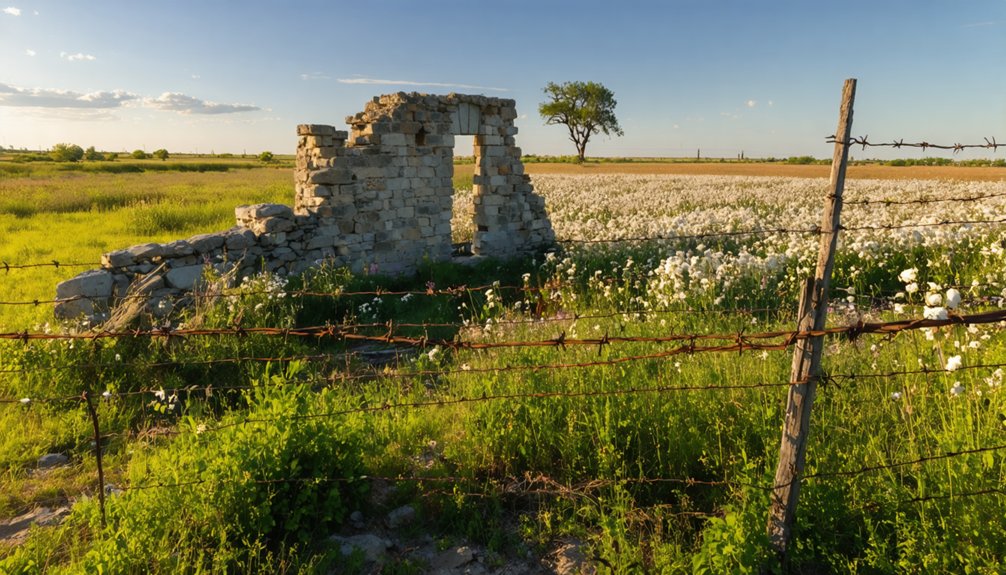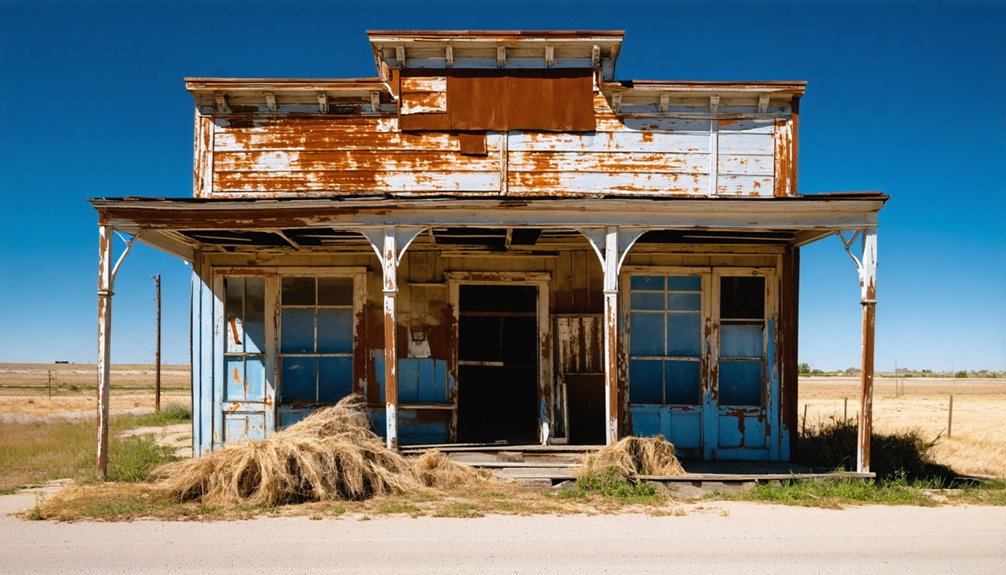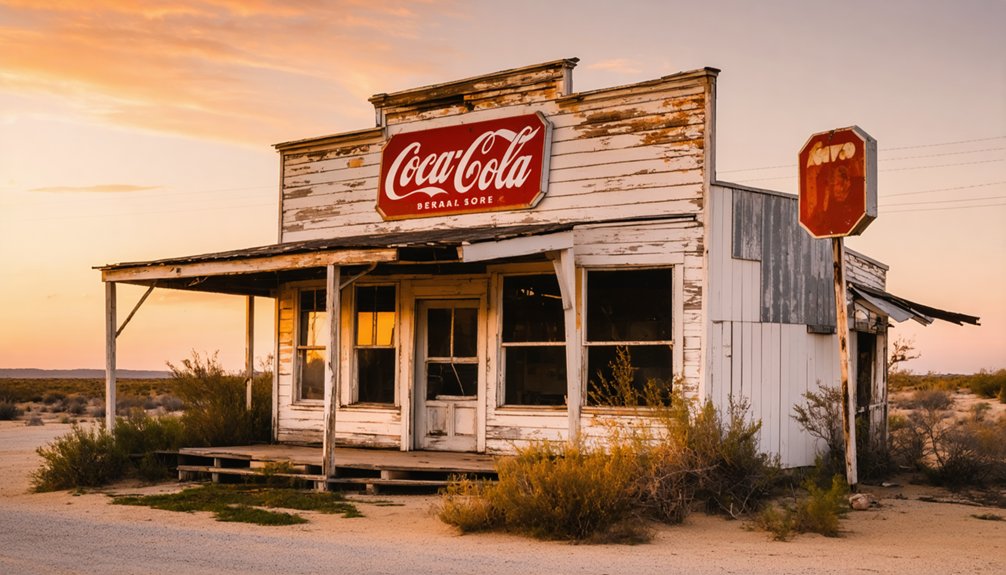You’ll find Old Gomez’s ghost town remains in Terry County, Texas, where ambitious speculators established it in 1902. Though it started strong with stores, a cotton gin, and a bustling dance hall, the town lost its bid for county seat to nearby Brownfield in 1904. When the Santa Fe Railway bypassed Gomez for Brownfield in 1916, the town’s decline accelerated. By 1918, the original townsite had reverted to farmland, leaving behind a tale of frontier dreams and railroad politics.
Key Takeaways
- Old Gomez was Terry County’s first organized settlement, established in 1902 but abandoned by 1918 when the townsite reverted to farmland.
- The town’s decline began when rival Brownfield secured both county seat status and the Santa Fe Railway connection five miles east.
- Key businesses included H.H. Longbrake’s public well, J.T. Gainer’s general store, and the first cotton gin established in 1904.
- Social life centered around Vernon Seitz’s dance hall, with community gatherings and seasonal celebrations marking agricultural milestones.
- Today, few physical remnants remain of Old Gomez, as nature and agriculture have reclaimed most of the original townsite.
The Rise and Fall of a Speculative Dream
When three ambitious speculators purchased ranch land in Terry County in 1902, they envisioned Gomez as a thriving metropolis that would serve as the county’s administrative heart. Their speculative ambitions led them to plat the town around a grand public square, anticipating a future courthouse that would cement their investment.
You’ll find the town’s early promise reflected in its rapid development, attracting merchants and even securing a post office named after Cuban general Máximo Gómez. The town initially enjoyed steady growth as local businesses moved in and prospered.
However, economic challenges soon emerged when rival speculators established Brownfield just five miles east. The decisive blows came in quick succession: Brownfield won the county seat election in 1904 and later secured the Santa Fe Railway connection in 1916.
Brownfield’s dual victories – winning both county seat status and railway access – spelled doom for its neighbor Gomez’s metropolitan aspirations.
Without rail access or political importance, Gomez’s dreams of greatness crumbled, and by 1918, the original townsite returned to farmland. Today, Gomez stands as one of 511 ghost towns scattered across Texas, with only a cemetery and historical marker remaining to tell its story.
Life in Early 1900s Gomez
If you’d lived in early 1900s Gomez, you’d have faced daily challenges like hauling water from H.H. Longbrake’s public well in the town square and relying on J.T. Gainer’s general store for essential supplies.
Much like the pioneering spirit of Jewish settlers who established trading posts in early America, you’d have conducted most of your business transactions at Wolf and Ware’s merchandise store, where locals gathered to exchange news and goods.
Your social life would’ve centered around Vernon Seitz’s dance hall, where community gatherings provided relief from the isolation of frontier living. The construction of the first cotton gin in 1904 brought new economic opportunities for local farmers.
Daily Pioneer Hardships
Living in early 1900s Gomez meant facing the relentless challenges of frontier life, where settlers had to navigate both isolation and harsh environmental conditions.
You’d have witnessed pioneer resilience firsthand as residents traveled long distances to reach the nearest major town of Lubbock, some 45 miles away.
Daily struggles included securing water from the town’s single public well, drilled by H. H. Longbrake in 1903. The decline in ranch productivity reflected broader economic challenges that plagued early Mexican Texas.
While the Wolf and Ware general store and Gainer’s shop provided essential supplies, you’d still need to be largely self-sufficient. Like many Mexican Americans of the era, some residents operated chili parlors to supplement their income.
The unpredictable nature of frontier life meant you’d likely need multiple sources of income to survive, combining farming, ranching, or commerce.
Community support became vital, with settlers depending on each other through gatherings at the dance hall and town square.
General Store Commerce
The Wolf and Ware general store stood as Gomez’s primary commercial hub in the early 1900s, offering essential goods to the frontier community. You’d find everything from basic foodstuffs to tools and clothing, making it crucial for local survival. Customers could browse through barrels of pickles and other staples stacked throughout the store.
The store exemplified community resilience, serving as both a trading post and social center where you could catch up on local news while bartering or paying cash for supplies. Much like the historic Market Square in Brownsville, it functioned as a vital gathering place for commerce and community activities.
Local entrepreneurship flourished as the store connected you to broader market networks through traveling peddlers and wholesalers. You’d often find the post office housed within, making it your critical link to the outside world.
The store’s presence strengthened Gomez’s economic foundation, though like many rural establishments, it would later face challenges from advancing urbanization and retail chains.
Community Social Activities
Social life in early 1900s Gomez centered around key gathering spots that shaped the frontier community’s vibrant character. You’d find residents congregating at the town’s first dance hall and saloon, both established in 1903, while the town square buzzed with activity around H.H. Longbrake’s public well. Like the community of Sweet Home, the town was established by former slaves seeking a fresh start.
- Your evenings might be spent at community events in the dance hall, where seasonal celebrations marked agricultural milestones. The community hosted their own baseball team that brought residents together for sporting entertainment.
- You could exchange news at T.J. Price’s blacksmith shop or join social gatherings at the one-room schoolhouse.
- You’d participate in community meetings about local governance at churches, blending civic duty with socializing.
- You’d find yourself part of communal work activities, where labor-intensive farming tasks brought neighbors together, strengthening frontier bonds.
Railroad Politics and County Seat Competition
While Gomez initially flourished as Terry County’s first settlement in 1902, intense railroad politics and county seat rivalries would ultimately seal its fate.
You’ll find that the Santa Fe Railway held tremendous power in shaping the region’s development, following their successful Kansas model of selling land to actual settlers rather than speculators.
Though Gomez’s founders campaigned vigorously for county seat status, leveraging their central location and thriving business district, railroad politics dramatically shifted the balance of power.
When the Santa Fe line bypassed Gomez and built east through Brownfield instead, it dealt a devastating blow to Gomez’s aspirations.
Despite competing railways like the Pecos Valley Southern attempting to enter the region, the Santa Fe’s strategic control of land routes proved decisive, leading to Gomez’s abandonment by 1918.
From Bustling Town to Agricultural Land

After losing its bid for county seat status, Gomez’s story shifted from urban aspirations to agricultural reality.
You’ll find a remarkable land transformation where cotton gins and storefronts once stood, as vast farmlands now stretch across the horizon. The agricultural evolution of Gomez showcases how economic forces and railroad politics can reshape a community’s destiny.
- You can still sense the echoes of bustling commerce where cotton farmers once brought their harvests to the local gin.
- The fertile plains that surrounded the former town now yield cotton and corn crops.
- Large ranching operations, like the Four Sixes Ranch, have woven themselves into the fabric of this transformed landscape.
- What was once mapped for urban development has surrendered to the practical demands of Texas agriculture, merging town plots into expansive farming operations.
Traces of the Past: What Remains Today
Today’s visitors to Old Gomez will find few physical remnants of the once-thriving community, as nature and agriculture have reclaimed most of the original townsite.
If you venture to explore the area, you’ll notice how the land has largely returned to its natural state, with farmland dominating where architectural remnants once stood. Environmental impacts of the town’s abandonment are evident in the way vegetation has overtaken any remaining foundations or markers of human habitation.
While the physical traces may be scarce, the site still holds historical significance as a reflection of the economic and social changes that shaped Texas’ rural landscape.
You’ll discover that Old Gomez’s story lives on primarily through historical records and the memories of former residents’ descendants rather than through tangible remains.
Historical Legacy on the South Plains

Despite its short-lived existence, Old Gomez left an indelible mark on Terry County‘s development as its first organized settlement in 1902.
You’ll find its cultural influences woven into the fabric of South Plains history, shaping the region’s community identity through its pioneering spirit and determination.
- You can trace Gomez’s unique heritage to its distinctive naming after Cuban general Máximo Gómez, reflecting the era’s Spanish-American War influences.
- The town established early patterns of community organization that later settlements would follow, from education to religious institutions.
- Gomez’s competitive bid for county seat status showcases the fierce independence of frontier towns.
- Its eventual adaptation to change, seen in the relocation of buildings and preservation of community memory, demonstrates the resilience of Plains settlers.
Frequently Asked Questions
What Were the Names of the Three Original Speculators Who Founded Gomez?
You’ll get a kick out of these bold founder backgrounds: J.F. Blankenship, Sam P. Ford, and the mysteriously named “Mr. Pool” used their speculation strategies to establish Gomez in 1902.
Did Any Famous Outlaws or Historical Figures Ever Visit Old Gomez?
You won’t find any verified visits from famous outlaws to Old Gomez. While outlaw legends and ghost stories surround many Texas ghost towns, there’s no historical evidence of notable figures stopping here.
What Was the Highest Recorded Population of Old Gomez During Its Peak?
You won’t find exact population figures for Old Gomez’s peak, as census records don’t document specific numbers. Despite early population growth prospects, the town declined before reaching substantial size.
Were There Any Significant Natural Disasters That Affected Old Gomez?
Even with today’s satellite tracking, you won’t find any recorded natural disasters that historically impacted Old Gomez. The town’s demise came purely from human factors like losing railway access.
What Businesses and Services Operated in Old Gomez Before Its Abandonment?
You’d find these ghostly businesses in Old Gomez: Wolf and Ware’s store, Gainer’s general store, Craig’s saloon, Seitz’s dance hall, Price’s blacksmith shop, and forgotten services like Bess’s post office.
References
- https://discovertexasoutdoors.com/places/gomez/
- https://www.ghosttowns.com/states/tx/oldgomez.html
- https://en.wikipedia.org/wiki/List_of_ghost_towns_in_Texas
- https://www.waymarking.com/waymarks/WMK8F2_Gomez
- https://www.texasescapes.com/Texas-Ghost-Towns-A-to-Z.htm
- https://www.texasescapes.com/TexasPanhandleTowns/Gomez-Texas.htm
- https://lindalenews.com/articles/77/view/texas-uneven-population-boom-is-creating-ghost-towns-in-many-rural-counties
- https://www.tshaonline.org/handbook/entries/gomez-tx
- https://hvmag.com/life-style/gomez-mill-house/
- https://www.tshaonline.org/handbook/entries/gomez-refugio



